Unpacking and publishing the Phaistos Disk since 1993
HOME | PREVIOUS | NEXT | SITEMAP
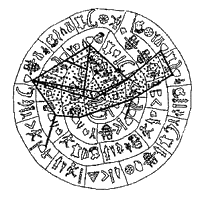
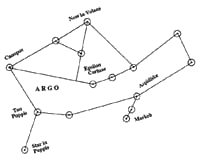

Isis found all the pieces of Osiris that Typhon had scattered, except for his "generative member." Unfortunately, it was eaten by the "sharp-snout" fish.  As a result the crab and the sharp-snout were venerated by the Egyptian priests and declared taboo to eat.
As a result the crab and the sharp-snout were venerated by the Egyptian priests and declared taboo to eat.
"Now, the only one of the parts of Osiris which Isis did not find was that which causes awe; for that it was cast straightway into the River...and the sharp-snout ate it up--which [they say] among fishes are considered specially expiate..." (71)
"...for as they venerate the sharp-snout fish, they fear that the hook is not pure when 'sharp-snout' is caught by it..." (72)
"Their priests, upon the other hand, abstain from all; and [even] on the ninth of the first month (September), when every one of the rest of the Egyptians eats a broiled fish before his front door, the priests do not taste it, but burn their fishes to ashes before he doors [of the Temple]." (73)
The sharp-snout appears four times in Side 2; twice on Side 1. Quadrilaterals may be formed of two triangles.  (4 Sharp-Snout fish connected)
(4 Sharp-Snout fish connected)
The Nile crab ![]() assisted the sharp-snout in devouring the phallus of Osiris. The Nile crab appears once on Side 1.
assisted the sharp-snout in devouring the phallus of Osiris. The Nile crab appears once on Side 1.
 As a god of vegetation Osiris was naturally conceived as a god of creative energy in general, since men at a certain stage of evolution fail to distinguish between the reproductive powers of animals and of plants. Hence a striking feature in his worship was the coarse but expressive symbolism by which this aspect of his nature was presented to the eye not merely of the initiated but of the multitude. At his festival women used to go about the villages singing songs in his praise and carrying obscene images of him which they set in motion by means of strings. The custom was probably a charm to ensure the growth of the crops. A similar image of him, decked with all the fruits of the earth, is said to have stood in a temple before a figure of Isis, and in the chambers dedicated to him at Philae the dead god is portrayed lying on his bier in an attitude which indicates in the plainest way that even in death his generative virtue was not extinct but only suspended, ready to prove a source of life and fertility to the world when the opportunity should offer. Hymns addressed to Osiris contain allusions to this important side of his nature. In one of them it is said that the world waxes green in triumph through him; and another declares, “Thou art the father and mother of mankind, they live on thy breath, they subsist on the flesh of thy body.” We may conjecture that in this paternal aspect he was supposed, like other gods of fertility, to bless men and women with offspring, and that the processions at his festival were intended to promote this object as well as to quicken the seed in the ground. It would be to misjudge ancient religion to denounce as lewd and profligate the emblems and the ceremonies which the Egyptians employed for the purpose of giving effect to this conception of the divine power. The ends which they proposed to themselves in these rites were natural and laudable; only the means they adopted to compass them were mistaken. A similar fallacy induced the Greeks to adopt a like symbolism in their Dionysiac festivals, and the superficial but striking resemblance thus produced between the two religions has perhaps more than anything else misled enquirers, both ancient and modern, into identifying worships which, though certainly akin in nature, are perfectly distinct and independent in origin.(GB, chap 40)
As a god of vegetation Osiris was naturally conceived as a god of creative energy in general, since men at a certain stage of evolution fail to distinguish between the reproductive powers of animals and of plants. Hence a striking feature in his worship was the coarse but expressive symbolism by which this aspect of his nature was presented to the eye not merely of the initiated but of the multitude. At his festival women used to go about the villages singing songs in his praise and carrying obscene images of him which they set in motion by means of strings. The custom was probably a charm to ensure the growth of the crops. A similar image of him, decked with all the fruits of the earth, is said to have stood in a temple before a figure of Isis, and in the chambers dedicated to him at Philae the dead god is portrayed lying on his bier in an attitude which indicates in the plainest way that even in death his generative virtue was not extinct but only suspended, ready to prove a source of life and fertility to the world when the opportunity should offer. Hymns addressed to Osiris contain allusions to this important side of his nature. In one of them it is said that the world waxes green in triumph through him; and another declares, “Thou art the father and mother of mankind, they live on thy breath, they subsist on the flesh of thy body.” We may conjecture that in this paternal aspect he was supposed, like other gods of fertility, to bless men and women with offspring, and that the processions at his festival were intended to promote this object as well as to quicken the seed in the ground. It would be to misjudge ancient religion to denounce as lewd and profligate the emblems and the ceremonies which the Egyptians employed for the purpose of giving effect to this conception of the divine power. The ends which they proposed to themselves in these rites were natural and laudable; only the means they adopted to compass them were mistaken. A similar fallacy induced the Greeks to adopt a like symbolism in their Dionysiac festivals, and the superficial but striking resemblance thus produced between the two religions has perhaps more than anything else misled enquirers, both ancient and modern, into identifying worships which, though certainly akin in nature, are perfectly distinct and independent in origin.(GB, chap 40)
When Isis set out to find Osiris contained with his specially designed coffin-chest, she sailed to Byblos, a "city in the Papyrus  Swamps of the Delta." (46)
Swamps of the Delta." (46)
When Isis returned to Egypt with the coffin, she hid it in the marsh swamps  of Buto.
of Buto.
"Of trilateral figuresa scalene triangle 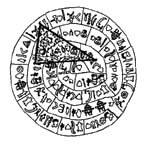 (3 Marsh Grass connected)that which has its three sides unequal."
(3 Marsh Grass connected)that which has its three sides unequal."
The loss of Osiris was a tragedy for the Egyptians, whom he had saved from a dire life of struggle.
"And they say that when Osiris was king, he straightway set free the Egyptians from a life from which they could find no way out and like unto that of wild beasts, both setting fruits  before them, and laying down laws, and teaching them to honour the Gods." (25)
before them, and laying down laws, and teaching them to honour the Gods." (25)
The triangle fruit may be the fruit of the triangle or geometry, i.e. knowledge or gnosis, which sets one free. This symbol may also represent the honey cake of Osiris or even a honey jar. It may also be a symbol for star and thus starlore and astronomy, conceived to be the study of geometrical arrangements of the stars.
This "triangle fruit" that Osiris set before the Egyptians appears 15 times on Side 2, 3 times on Side 1. By connecting the 3 signs on Side 1, an acute-angled triangle 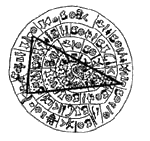 (3 Triangle Fruit connected) is revealed, a triangle which has its three angles acute." (17) By connecting the 15 signs on Side 2, the constellation Argo is revealed.
(3 Triangle Fruit connected) is revealed, a triangle which has its three angles acute." (17) By connecting the 15 signs on Side 2, the constellation Argo is revealed.
Osiris "went forth over the whole earth," sailing the Heaven-Ocean in the Argo. (below) At the prow of the Argo is the pilot, the star "'Kanobus' (Canopus), or 'Pilot'--from whom, they say, the star got its name." (27) Osiris is the General and Kanobus is the Pilot. (28) The Argo is drawn by connecting together the tips of the triangle fruit (or stars) distributed by Osiris. If the symbol represents star, then the meaning seems to be that Osiris is credited with distributing the stars in the heavens.



"And [they say] that the ship which Greeks call Argo is an image of the bark of Osiris, constellated in his honour, and that it sails not far from Orion and Dog, the former of which Egyptians consider the sacred [boat] of Horus and the latter of Isis." (Plutarch)
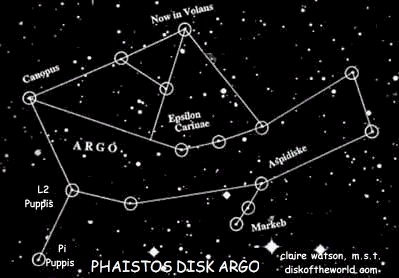
Osiris was trapped in the coffin  by his brother Typhon.
by his brother Typhon.
Typhon, plotting to kill Osiris, built a coffin-chest  in which to entrap him. A chest, in Pythagorean terms, is "an odd-ly ordered rectangular encasement." (33)
in which to entrap him. A chest, in Pythagorean terms, is "an odd-ly ordered rectangular encasement." (33)
"But that after measuring out for himself in secret the body of Osiris, and having devised, according to the size, a beautiful and extraordinarily ornamented chest, brought it into the banqueting hall." (34)
All in the banqueting hall were delighted with the coffin-chest. Typhon offered to give the coffin to anyone whom it fit perfectly. At this time Osiris had been king for 28 years. (35)
All Egyptian culture was of religious origin. Astronomy arose from the need to maintain the timing necessary for ritual, i.e. the rising of Sothis, the phases of the moon. The oldest maps concerned the 'geography of the beyond'; they were painted on the bottom of coffins as signposts to the next world. (g and g, intro)
Egyptians to be allowed to continue living as a small lamp among the constellations of night, hence coffins were adorned with stars. The circumpolar stars received special respect for they were regarded as the 'imperishable ones' because they never sank in the west. (g nd g, p 116)
Now the "night of the things of the night festival in Sekhem" signifieth the light of the rising sun on the coffin of Osiris. (ebod, p.302)
"Further, of trilateral figures, a right angled triangle 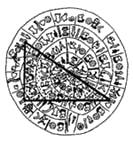 (3 Coffin-chests) is that which has a right angle,
(3 Coffin-chests) is that which has a right angle,
an obtuse-angled triangle 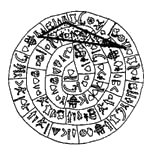 (3 Coffin-Chests) that which has an obtuse angle.
(3 Coffin-Chests) that which has an obtuse angle.
Isis arrived in Byblos and met the people there, who noticed right away that her breath, hair and skin smelled like ambrosia. (55) Isis planned to retrieve the damaged coffin ![]() and body of Osiris from inside the heather-tree in the palace, and she entered the palace when the queen of Byblos employed her as a nurse for her baby son Diktys.
and body of Osiris from inside the heather-tree in the palace, and she entered the palace when the queen of Byblos employed her as a nurse for her baby son Diktys.
 .
.
Hand - To ancient peoples the hand was a symbol of creative power.(go and g, p. 57)
Right-hand signs  symbolizing North, of both the cosmos and of Egypt. (78) "To ancient people the hand was a symbol of creative power." (The God and Symbols of Ancient Egypt, Manfred Lurker, Thames and Hudson, 1974, p. 57)
symbolizing North, of both the cosmos and of Egypt. (78) "To ancient people the hand was a symbol of creative power." (The God and Symbols of Ancient Egypt, Manfred Lurker, Thames and Hudson, 1974, p. 57)
"And there is a sacred dirge made on Kronos (Nile)--and it laments 'him who is born in the left-hand and died in the right-hand parts.' For Egyptians think that the eastern [parts] of cosmos are 'face,' the northern 'right hand,' and the southern 'left hand.' The Nile, accordingly, since it flows from the southern [parts] and is consumed by the sea in the northern, is naturally said to have its birth in the left hand and its death in the right hand." (79)
The right hand symbolizes Upper Egypt, and the left hand Lower Egypt. (80) The papyrus also symbolizes "'southern climate' of the cosmos," (81) or The Southern Hemisphere. On Side 1, the papyrus appears 3 times, each time with a heaven-walker.
Many of the patterns on the disk probably are constellations of the Northern and Southern Hemispheres as they appeared 3,600 years ago. Seen on Side 2 are Orion Because there was a full moon, Typhon was out hunting pigs
Pig - The pig appeared in special relation to the moon; it was slaughtered at lunar festivals and presented to the moon-gods, Isis and Osiris. One myth relates how the sky goddess Nut assumed the form of a pig and devoured her own childrne, the stars. (g and g, p 95)
Typhon threw Osiris in the coffin into the Nile River
"Parallel straight lines are straight lines which, being in the same plane and being produced indefinitely in both directions, do not meet one another in either direction." (15) Two or more straight lines, having no points in common, may be of the same magnitude but not parallel.
Quadrilateral figures are contained by four straight lines.
From Sah's belt hung the 7 stars of the Pleiades.
On Side 1 of the disk are 15 round shields, each containing 7 dots.
Nemasa, and Sah, "Orion." The reading in Lepsius is Masti, "gods of the thigh." 8. Var. "their years are the years of Osiris." (ebod, 292)
Sothis - The dog star Sirius that was deified as a goddess and shown as a woman with a star on her head. Sothis, represented as a large dog, was later associated with Isis. (g and g, 114)
Cosmic House of Horus "And [they say] that when Isis had gone a journey to her son Horus, who was being reared at Boutos..." (93)
The Egyptians tell a myth about Zeus (Typhon) that, as in consequence of his having his legs grown together,
In Egypt, feasts celebrating the immortality of Osiris begin with a procession of the priests headed by a water-vase, symbolizing the Water of Life. The water-vase "And they call not only the Nile, but also without distinction all that is moist, 'Osiris efflux;' and the water-vase always heads the processions of the priests in honor of the God." (86)
"Parallel straight lines are straight lines which, being in the same plane and being produced indefinitely in both directions, do not meet one another in either direction." (15)
Two or more straight lines, having no points in common, may be parallel and of different magnitude LOOKING FOR THE EQUILATERAL TRIANGLE SIGN AND WHERE IT GOES
"Again, by the relative position of its (the ibis') legs to one another, and [of those] to its beak, it forms an equilateral triangle..." (12)
"Again, by the relative position of its (the ibis') legs to one another, and [of those] to its beak, it forms an equilateral triangle..." (12)
The Egyptians celebrated the Burials of Osiris by cutting a tree-trunk and making it into a crescent-shaped coffin
On Side 2 of the disk is the crescent-shaped coffin (damaged area) beside the skiff. The dots inside the crescent sign probably once numbered 28, the number of years Osiris reigned and the number of the lunar cycle.
The character of Osiris as a tree-spirit was represented very graphically in a ceremony described by Firmicus Maternus. A pine-tree having been cut down, the centre was hollowed out, and with the wood thus excavated an image of Osiris was made, which was then buried like a corpse in the hollow of the tree. It is hard to imagine how the conception of a tree as tenanted by a personal being could be more plainly expressed. The image of Osiris thus made was kept for a year and then burned, exactly as was done with the image of Attis which was attached to the pine-tree. The ceremony of cutting the tree, as described by Firmicus Maternus, appears to be alluded to by Plutarch. It was probably the ritual counterpart of the mythical discovery of the body of Osiris enclosed in the erica-tree. In the hall of Osiris at Denderah the coffin containing the hawk-headed mummy of the god is clearly depicted as enclosed within a tree, apparently a conifer, the trunk and branches of which are seen above and below the coffin. The scene thus corresponds closely both to the myth and to the ceremony described by Firmicus Maternus. 1 )GB, chap 40)
Quadrilateral figures are contained by four straight lines.
Typhon would never have known of the union of Osiris and Nephthys had not Osiris left behind the wreath of honey-clover. The plant appears 4 times on Side 2 of the disk; 3 times with a dog
"And when the Nile exceeds its boundaries and overflows more than usual, and [so] consorts with the extreme districts, they call it the union of Osiris with Nephthys--proof of which is given by the springing up of plants, especially the honey-clover, for it was by its falling [from Osiris] and being left behind that Typhon was made aware of the wrong done to his bed. Hence it is that Isis conceived Horus in lawful wedlock, but Nephthys Anubis clandestinely." (31)
"There is, then, for the worshippers of Anubis some [mystery] or other that may not be spoken of." (32)
The priests and priestesses of Thoth, who convened deep within Cheops, were called Beings of Light because, as mortals, they unveiled Isis, they "re-vealed her robe." While still in the body they lifted the curtain of space-time and energy-matter and gained enlightenment from The Boundless Light. During the initiations into the mystery religion, the initiates were "hood-winked" "Wherefore when they have once and once only received this [robe], they treasure it away and keep it from all eyes and hands; whereas they use those of Isis on many occasions." (107)
After the initiation the Divine Mysteries were slowly revealed to the Select, and the priests and priestesses worked to elevate the initiates, called Mortals, to the grade of Intelligences, or those who had received the Nous (Mind), known to them as Thoth. At the center of the mystery-myth was the Ritual of the Portal and the means by which the physical person received in Divine Marriage a Heavenly Partner. The Nous or Heavenly Partner brings the Gnosis and the direct knowledge of the inner way to Thoth's celestial City of 8, the 8th sphere (Ogdoad) and infinity, symbolized perhaps by the figure 8's on the cheeks of the priests,
"Himself is far, far from the earth, unspotted and unstained, and pure of every essence that is susceptible of death and of decay. Nor can the souls of men here [on the earth], swathed as they are with bodies and enwrapped in passions, commune with God, except so far as they can reach some dim sort of a dream [of Him], with the perception of a mind trained in philosophy. But when [their souls] freed [from these bonds] pass to the Formless and Invisible and Passionless and Pure, this God becomes their guide and king, as though they hung on Him, and gazed insatiate upon His Beauty, and longed after it-[Beauty] that no man can declare or speak about. It is with this the ancient tale makes Isis e'er in love, and, by pursuit [of it], and consort [with it], makes [her] full-fill all things down here with all things fair and good, whatever things have part in genesis." (108)
Let us do as Isis did. Let us re-member Osiris.
Remember Sirius.
When Isis, Lady of the Heart and Tongue, learned of the deed done to Osiris, it broke her heart. The tree sacred to Isis was the Persea, because its fruit
Two straight lines may produce adjacent angles
The ram also symbolizes Hermes (Thoth), the good Shepherd of Men. "Statues of Hermes Kriophoros, or Hermes with a ram or lamb standing beside him, or in his arms, or on his shoulder, were one of the most favourite subjects for the chisel in Greece. We have specimens dating to the archaic period of Greek art." (44)
The concealed heptagram of the Phaistos Disk is part of the ancient Osirian religion-science founded on the vertex-vortex and a geometry-based number philosophy, correlated herein to the 13 portals of the curtain of space-time and energy-matter. The number philosophy and the heptagram illustrate "the development of the method of 'exhaustion,' which shows how to 'exhaust' the area of a circle by means of an inscribed polygon; if we successively double the number of sides in the polygon, we will eventually reduce the difference between the area of the polygon (known) and the area of the circle (unknown) to the point where it is smaller than any magnitude we choose. This method made it possible to calculate the area of a circle to any desired degree of accuracy; with a little further development, it could be used to calculate the area within (or under) other curves as well" (18) and to calculate "the area bounded by certain spirals, and the surface area and volume of a sphere." (19)
The method of exhaustion was "probably borrowed by Euclid from his predecessor Eudoxus," (20) (400-355 BCE), a Greek astronomer and mathematician credited with this inventive method of calculating proportion. The Phaistos Disk seems to show exhaustion in use 1200 years before Eudoxus.
The number philosophy makes of a circle, in the mystical sense, an alchemical vessel, a Mixing Bowl, in which can be seen and analyzed the alchemical stages in the action of the Absolute in differentiating Self into a phenomenal universe through geometry. Each alchemical stage is introduced with 1-13 of the 13 precepts of the Emerald Table of Hermes Trismegistus, a legendary alchemical enigma and text puzzle.
Various cultures claim to have discovered the Emerald Table-Tabula Smaragdina. In one account of discovery, Alexander the Great found the table in the tomb of Hermes (Thoth). In another account, Sarah the wife of the biblical Abraham, found the entombed Hermes holding in his hands his table. Alternately, the precepts may have been written in Syriac.
"These precepts of Hermes were cherished with a kind of religious fervour by the adepts (of alchemy), who looked upon them as summarising in a concealed form the fundamental secrets of alchemy and of the Philosopher's Stone." (21)
Precept 1. "I speak not fictitious things, but that which is certain and true." The point within the circle,
Precept 2. "What is below is like that which is above, and that which is above is like that which is below, to accomplish the miracles of one thing." The cross within the circle is P2.
Precept 3. "And as all things are produced by the one word of one Being, so all things were produced from this one thing by adaptation." The triangle within the circle is P3.
Precept 5. "It is the father of perfection throughout the world." The pentagon and pentagram are P5.
Precept 6. "The power is vigorous if it be changed into earth." The hexagon and hexagram are P6.
Precept 7. "Separate the earth from the fire, the subtle from the gross, acting prudently and with judgment." The heptagon and heptagrams are P7.
"Only [the Hermetic Star] indicated the science of its owner by this characteristic sign of the Work, the one and only star. All those who undertake the Work seek to obtain the Star." (Nicholas Rollin, 1447 CE)
Precept 8. "Ascend with the greatest sagacity from the earth to heaven, and then again descend to the earth, and unite together the powers of things superior and things inferior. Thus you will obtain the glory of the whole world, and obscurity will fly far away from you." The octagon and octagrams are P8.
Precept 9. "This has more fortitude than fortitude itself, because it conquers every subtle thing and can penetrate every solid." The enneagon and the enneagrams are P9.
Precept 10. "Thus was the world formed." The dekagon and the dekagrams are P10.
Precept 11. "Hence proceed wonders, which are here established." The endekagon and the endekagrams are P11.
Precept 12. "Therefore, I am called Hermes Trismegistus, having three parts of the philosophy of the whole world." The dodekagon and the dodekagrams are P12.
Precept 13. "That which I had to say concerning the operation of the sun is completed." P13 is the fully corporeal universe.
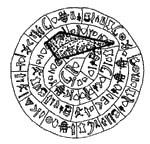 (4 right-hand signs connected)
(4 right-hand signs connected)

 . The manner of Osiris' death is symbolic because he was very much like the trees and the grass. He became destined to rule the underworld by virtue of his death. Osiris in the Nile is the archetype for purification by baptism in sacred water. To the ancient Egyptians who farmed the Nile Delta, Osiris literally was the Nile. He went directly into the water, where he himself was purified, and then he
floated down the Nile River to a place called Byblos. There he was formed into the trunk of a tree,
from which he grew to be a beautiful heather-tree.
. The manner of Osiris' death is symbolic because he was very much like the trees and the grass. He became destined to rule the underworld by virtue of his death. Osiris in the Nile is the archetype for purification by baptism in sacred water. To the ancient Egyptians who farmed the Nile Delta, Osiris literally was the Nile. He went directly into the water, where he himself was purified, and then he
floated down the Nile River to a place called Byblos. There he was formed into the trunk of a tree,
from which he grew to be a beautiful heather-tree.  Typhon threw Osiris into the Nile River.
Typhon threw Osiris into the Nile River.  (2 skiffs, 2 Niles signs connected).
(2 skiffs, 2 Niles signs connected). 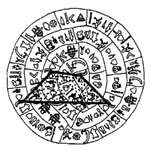 (4 Nile signs)
(4 Nile signs)  The main southern constellation of Orion was called Sah by the Egyptians and had already been early equated with Osiris. In religious texts one finds the notion of the sorrowing Isis in the form of Sirius (Sepdet in Egyptian, corrupted to Sothis in Greek) following Orion, the 'glorious soul of Osiris'. (g and g, p. 116)
The main southern constellation of Orion was called Sah by the Egyptians and had already been early equated with Osiris. In religious texts one finds the notion of the sorrowing Isis in the form of Sirius (Sepdet in Egyptian, corrupted to Sothis in Greek) following Orion, the 'glorious soul of Osiris'. (g and g, p. 116) A man is holding one of the shields in his hand, defining them as hand shields.
A man is holding one of the shields in his hand, defining them as hand shields. 

 what may be the "Cosmic House of Horus," (92) which may represent the procession of the priests. The Cosmic House of Horus
what may be the "Cosmic House of Horus," (92) which may represent the procession of the priests. The Cosmic House of Horus  also may represent a structure in the constellation Bootes.
also may represent a structure in the constellation Bootes.![]() he could not walk, for shame he lived in solitude; and so Isis, by cutting in two and separating these limbs of his body, made his going even-footed." (30) The Typhon sign appears 5 times on Side 2. Beside the first sign on Side 2, along the outside edge and moving clockwise, is the coffin in which Typhon trapped his brother Osiris. The direction of clockwise means we are now referencing the Southern Hemisphere.
he could not walk, for shame he lived in solitude; and so Isis, by cutting in two and separating these limbs of his body, made his going even-footed." (30) The Typhon sign appears 5 times on Side 2. Beside the first sign on Side 2, along the outside edge and moving clockwise, is the coffin in which Typhon trapped his brother Osiris. The direction of clockwise means we are now referencing the Southern Hemisphere.  . After Typhon trapped Osiris in the chest and threw him into the Nile, the Pans and Satyrs
. After Typhon trapped Osiris in the chest and threw him into the Nile, the Pans and Satyrs ![]() living in Panopolis told the population the dire fate of Osiris, whereupon a "panic," derived from the name Panopolis, broke out. (37)
living in Panopolis told the population the dire fate of Osiris, whereupon a "panic," derived from the name Panopolis, broke out. (37)

 is seen twice on Side 2.
is seen twice on Side 2. The women of Greece gave Dionysus (Osiris) the epithet of "bull-born" and "call(ed) him up out of the water with the sound of trumpets...
The women of Greece gave Dionysus (Osiris) the epithet of "bull-born" and "call(ed) him up out of the water with the sound of trumpets...
 they hid in thyrsi." (90) The trumpets are the legendary "deep-toned (bellower) pipe of Idaean Kuretes." (91)
they hid in thyrsi." (90) The trumpets are the legendary "deep-toned (bellower) pipe of Idaean Kuretes." (91) 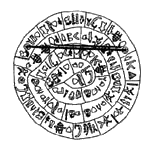 (2 water-vases, 2 hand shields connected) or of the same magnitude but not parallel.
(2 water-vases, 2 hand shields connected) or of the same magnitude but not parallel.
![]() Seen on Side 2 of the disk is the equilateral triangle, thought to symbolize the Three Primordial Principles--Osiris, Isis and Horus (11)--also symbolized by Ibis-headed Thoth.
Seen on Side 2 of the disk is the equilateral triangle, thought to symbolize the Three Primordial Principles--Osiris, Isis and Horus (11)--also symbolized by Ibis-headed Thoth.![]() Seen on Side 2 of the disk is the equilateral triangle, thought to symbolize the Three Primordial Principles--Osiris, Isis and Horus (11)--also symbolized by Ibis-headed Thoth.
Seen on Side 2 of the disk is the equilateral triangle, thought to symbolize the Three Primordial Principles--Osiris, Isis and Horus (11)--also symbolized by Ibis-headed Thoth. With 20 dots in its center, the equilateral triangle of the disk symbolizes one of the five Platonic solids, the icosahedron, composed of 20 equilateral triangles.
With 20 dots in its center, the equilateral triangle of the disk symbolizes one of the five Platonic solids, the icosahedron, composed of 20 equilateral triangles.
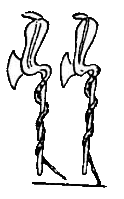

 like the one containing the coffin and body of Osiris in the skiff of Isis. (61)
like the one containing the coffin and body of Osiris in the skiff of Isis. (61)  Isis learned of Osiris' mistake when she saw the wreath of honey-clover that fell from him and was left behind in the bed.
Isis learned of Osiris' mistake when she saw the wreath of honey-clover that fell from him and was left behind in the bed. ![]() Isis went in search of Anubis, the child of this union.
Isis went in search of Anubis, the child of this union.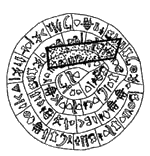 (4 Honey-clovers connected)
(4 Honey-clovers connected)![]() that probably represents Anubis.
that probably represents Anubis.
 with the hood of a robe, and were given two robes, the Robe of Isis, symbolizing the veil of Isis, which they wore openly, and the Robe of Osiris,
with the hood of a robe, and were given two robes, the Robe of Isis, symbolizing the veil of Isis, which they wore openly, and the Robe of Osiris,  which they put away. (106) The two hood-winks of the two robes appear on Side 2.
which they put away. (106) The two hood-winks of the two robes appear on Side 2. by the 8-petaled flax flower,
by the 8-petaled flax flower,  by the figure 8 shape of the Bone of Horus
by the figure 8 shape of the Bone of Horus  and by the Figure 8 shield formed by placing together Sides 1 and 2 of the disk.
and by the Figure 8 shield formed by placing together Sides 1 and 2 of the disk.  When the 8th sphere was attained, the initiates were no longer Mortals but Intelligences who merged themselves with Thoth and with Osiris, with Mind and Idea, for Osiris:
When the 8th sphere was attained, the initiates were no longer Mortals but Intelligences who merged themselves with Thoth and with Osiris, with Mind and Idea, for Osiris:
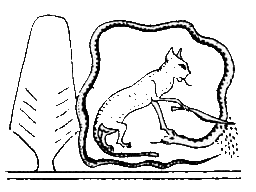
 resembles a heart and its leaf a tongue. (42) This fruit appears twice on Side 2 of the disk.
resembles a heart and its leaf a tongue. (42) This fruit appears twice on Side 2 of the disk. (2 Isis, 2 Persea fruit connected),
(2 Isis, 2 Persea fruit connected),  the queen's sceptre.
the queen's sceptre. ![]()
 In modern Hermeticism of the 20th century, from The Hermetic Order of the Golden Dawn, Isis is seen holding a similar sceptre (left, Illus. 2).
In modern Hermeticism of the 20th century, from The Hermetic Order of the Golden Dawn, Isis is seen holding a similar sceptre (left, Illus. 2). 
 The sacred sheep, which appears once on Side 2, is the ram with curved horns, widely recognized in Egypt to represent Amun, the sun-god. Amun was identified in the New Kingdom as Amon-Ra, the sun-god. The date of the New Kingdom (1567-1085 BCE) corresponds with the date of the Phaistos Disk (1600-1500 BCE). The ram-headed god, Khnum, was usually represented with horizontally projecting horns whilst those of the ram of Amun were curved downward. (The God and Symbols of Ancient Egypt," Manfred Lurker, Thames and Hudson, publishers, 1974, p.65).
The sacred sheep, which appears once on Side 2, is the ram with curved horns, widely recognized in Egypt to represent Amun, the sun-god. Amun was identified in the New Kingdom as Amon-Ra, the sun-god. The date of the New Kingdom (1567-1085 BCE) corresponds with the date of the Phaistos Disk (1600-1500 BCE). The ram-headed god, Khnum, was usually represented with horizontally projecting horns whilst those of the ram of Amun were curved downward. (The God and Symbols of Ancient Egypt," Manfred Lurker, Thames and Hudson, publishers, 1974, p.65).
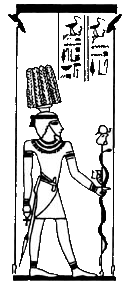 Hermes (Thoth) holds the Rod of Hermes (left), a form of the caduceus like the rod of Moses that was changed into a snake. This rod is topped by the world-sphere--the heaven-sphere or Pleroma of the Egyptian ankh.
Hermes (Thoth) holds the Rod of Hermes (left), a form of the caduceus like the rod of Moses that was changed into a snake. This rod is topped by the world-sphere--the heaven-sphere or Pleroma of the Egyptian ankh. seen on the Riddle of the Stone, is P1. The point symbolizes the negative space of Daath (portal).
seen on the Riddle of the Stone, is P1. The point symbolizes the negative space of Daath (portal).  "...[the] Boundless Point, from which the most minute begins to increase by parts. For the Point which is nothing and is composed of nothing, though partless, will become by means of its own Thought a Greatness beyond our own comprehension. This point is the Kingdom of the Heavens, the 'grain of mustard seed,' the partless point, the first existing for the body; which no one knows save the spiritual alone." (22) (North American Pima Indian basket, left)
"...[the] Boundless Point, from which the most minute begins to increase by parts. For the Point which is nothing and is composed of nothing, though partless, will become by means of its own Thought a Greatness beyond our own comprehension. This point is the Kingdom of the Heavens, the 'grain of mustard seed,' the partless point, the first existing for the body; which no one knows save the spiritual alone." (22) (North American Pima Indian basket, left)

 Precept 4. "Its father is the Sun, its mother the Moon; the wind carries it in its belly, its nurse is the earth." The square within the circle is P4.
Precept 4. "Its father is the Sun, its mother the Moon; the wind carries it in its belly, its nurse is the earth." The square within the circle is P4.  These first 4 forms comprise the triangular architecture of Cheops and also demonstrate the negative space that Kabalism calls "daath," and there herein we term "portal."
These first 4 forms comprise the triangular architecture of Cheops and also demonstrate the negative space that Kabalism calls "daath," and there herein we term "portal." 





 The original Hermetic Star Sirius within the heptagram of the 7 planets is today the heptagram above, center.
The original Hermetic Star Sirius within the heptagram of the 7 planets is today the heptagram above, center.

















| Symbolic Meaning/ Value |
Pictographs on Phaistos Disk |
Pictograph Origin/ Syncretisms |
| Value 1 - Plentitude |  |
Flax Flower; Lotus; Sun; Symbol of Ra; World; Constellation Octans |
| Value 2 - Intellect |  |
Osiris; Priest of Isis and Osiris; Priest of Horus |
| Value 3 - Cleanliness | Sweep of Osiris; Feather; Symbol of Purification | |
| Value 4 - Motion |  |
Heaven Walker; Divine Being; Osiris moving through the universe |
| Value 5 - Imprinting |  |
Papyrus; Written Word/Logos; Phallus of Osiris; Sheaf of Wheat |
| Value 6 - Positioning |  |
From Sumerian symbol, House of the God/Goddess; As above, so below |
| Value 7 - Multi- dimensionality |
 |
Thyrsuses - Bamboo Wand and Cone Papyrus |
| Value 8 - Purity |  |
Heather Tree; Five-branched; Purified One |
| Value 9 - Power |  |
Body of Osiris; Foes of Osiris; Hide of a bull; Leopard skin; Imuit (protector) |
| Value 10 - Divinity |  |
Horus |
| Value 11 - Contentment |  |
Shield of Osiris; Visible Universe; Pleiades |
| Value 12 - Logic |  |
Pi; Pyramid Builder |
| Value 13 - Wisdom |  |
Sceptre of Osiris |
| Value 14 - Energy |  |
Serpent Power; Electromagnetics; Constellation Serpens Cauda |
| Value 15 - Ascension |  |
Golden Hawk of Horus with Lodestone; Constellation Aquila |
| Value 16 - Spectrum |  |
UFO |
| Value 17 - Importing |  |
Pyramid |
| Value 18 - Feminine Nurturing |
 |
Isis |
| Value 19 - Sovereignty |  |
Falcon of Horus; Power that imparts the Light |
| Value 20 - Yoga |  |
Yoke; Constellation Bootes |
| Value 21 - Virility |  |
Bull's Foot of Apis; Constellation Taurus |
| Value 22 - Womb |  |
Skiff of Isis |
| Value 23 - Form |  |
Sharp-Snout Fish |
| Value 24 - Force |  |
Nile Crab |
| Value 25 - Regeneration |  |
Marsh Grass; Corn plant |
| Value 26 - Pattern |  |
Honey Cake; Star |
| Value 27 - Geometry |  |
Coffin-Chest; Rectangle |
| Value 28 - Resurrection |  |
Discarded Coffin; Trunk of the tree |
| Value 29 - Friendship |  |
Right Hand Sign; Southern Egypt; Southern Hemisphere |
| Value 30 - Fruitfulness |  |
Pig |
| Value 31 - Baptism |  |
River Nile; Body of Water |
| Value 32 - God |  |
Osiris and Shield; Orion, the Hunter; Orion nebula, newly born stars that hang from Orion's belt; Seven stars of the Pleiades |
| Value 33 - Personality |  |
Big Dog; Sirius the Dog Star; Constellation Canis Major |
| Value 34 - Faithfulness |  |
Dogs; Canis Minor; Sirius A and B |
| Value 35 - Multiplicity |  |
Cosmic House of Horus; |
| Value 36 - Parameter |  |
Typhon |
| Value 37 - Mythology |  |
Pan and Satyr |
| Value 38 - Containment |  |
Water Vase/Water of Life |
| Value 39 - Sanctity |  |
Herald Trumpet |
| Value 40 - Equality |  |
Equilateral Triangle |
| Value 41 - Decision |  |
Typhon's Hatchet |
| Value 42 - Perpetuity |  |
Crescent-Shaped Coffin; Lunar Nights |
| Value 43 - Victory |  |
Honey-Clover |
| Value 44 - Gnosis |  |
Hood of the Robe of Isis/Osiris |
| Value 45 - Love |  |
Persea Fruit; Heart Chakra |
| Value 46 - Manifestation |  |
Wand of Isis |
| Value 47 - Devotion |  |
Ram and Sheep; Symbol of god Amun-Ra Symbol for Hermes/Thoth |
Copyright Notice - Disk of the World - Text and images copyrighted March 21, 1993-2025, Claire Grace Watson, B.A., M.S.T., U.S. Copyright and under the Digital Millennium Copyright Act of 1998, All rights reserved. No part of this web page may be reproduced or transmitted in any form or by any means without written permission from the author, except for the inclusion of brief quotations in a review.